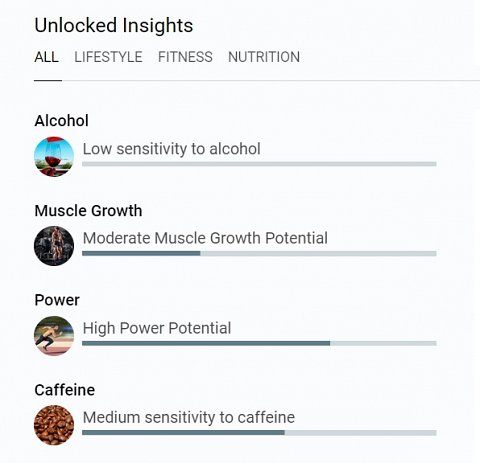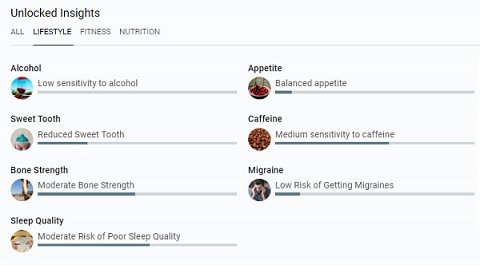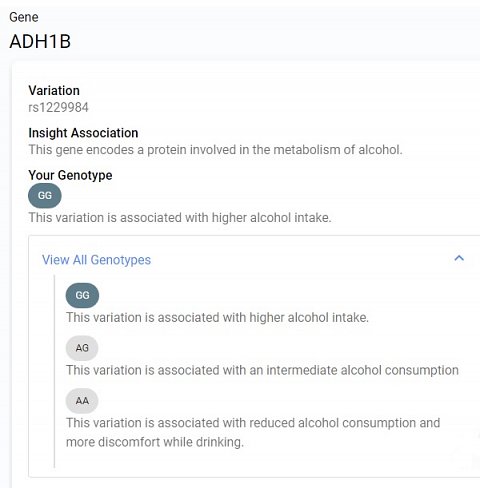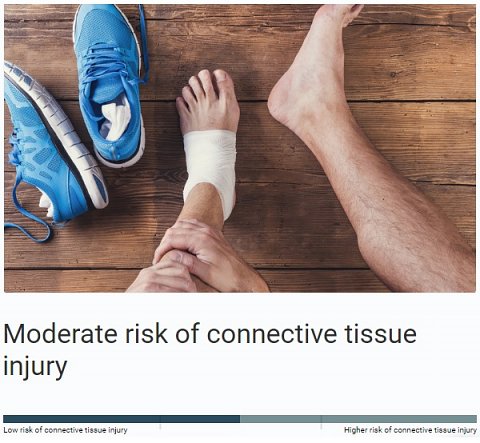-
AthGene Premium
review on 24 July 2017
by Craig Macpherson

At a Glance
Summary
The AthGene test provided a fun insight into my nutrition, fitness and lifestyle. It opened my eyes to the range of aspects that can impact my health, leading me to reconsider not just how much I eat or exercise, but which types of foods I put into my meals and which exercises would work best to reach my fitness goals.
I thought the explanations of my genetic results and the implications they might have for my health were amazingly thorough, though the fact that the information was often provided in large blocks of text was, at times, a little overwhelming. This said, the content was informative yet interesting, and helped me to fully understand the conclusions made. I enjoyed the AthGene test and would recommend it to those wanting a wide range of comprehensive information to use in leading a healthier lifestyle.
Full Review
AthGene is a Danish company that offers DNA testing focused on helping customers to improve their lifestyles, optimise their fitness routines and personalise their nutrition decisions. The company was set up by Yusafa Sey (current CEO) with co-founders Sebastian Tomsen and Theis Thorn, who together have a wide range of experience in science and technology. The company states its belief in “a future in which individuals have democratised access to their unique genetic information”, empowering them to unlock their full potential.
Product Expectations
AthGene covers three areas of DNA analysis: fitness, nutrition and lifestyle. The company is unusual in offering not only packages, including several analyses, but ‘Single Insights’. These start at £13 each and allow customers to pick as many or as few analyses as they like, from the full list of 30 options. I hadn’t decided exactly what I wanted to know about my health, so looked at the menu of packages to see what they had to offer.
There were four to choose from, one for each of the areas mentioned previously (fitness, nutrition and lifestyle) and one, the AthGene Premium package, that included all of the available insights. The latter of these seemed to be the most comprehensive option, so I clicked to find out more. I read that this entitled me to 30 points to use on whichever insights I wanted (though as there were 30 in total it was pretty easy to choose!)
A GIF that showed the kit being opened accompanied each of the product descriptions. I haven’t ever seen this method used to show the contents of a kit before, but thought it was really effective. There was also a link to the full list of insights, allowing me to read about each in more detail. This included information about which gene(s) would be analysed to report on each of the aspects of my health.
A ‘How it works’ section went through the process of testing, which seemed pretty straightforward. I learnt that the results would take around six to eight weeks to be delivered once my sample had reached the lab. I was also pleased to read that my genetic data wouldn’t be shared with any third parties, though later found out, in the terms and conditions, that AthGene could use my DNA data to develop their own products, which I would have no claim to.
Ordering Experience
I was easily able to add the test to my cart and was pleased to see that shipping was free, despite AthGene being based in Denmark. I was given the option to pay with my credit card via Stripe or by using PayPal.
Once my payment had gone through, I received an email confirming the order and the kit arrived a few days later. To register it online I had to set up an account, which only required me to enter my email address and a password of my choice. I was then able to enter the barcode on my kit to link it to my account, as this was how I would access my results once they were ready. I got an email confirming that my registration had been successful and sent my sample back via the prepaid postage provided.
10 days after I’d sent my sample off I got an email from AthGene to check whether I’d sent it, as they hadn’t yet received it. I thought this was really attentive. I replied to confirm that I had and received the results around a month later.
The Results
An email informed me that my results were available via the online account I’d set up during the registration process. I logged in and was shown a summary of all of my results on the homepage. A section of this is shown below.

A part of my results summary.
This page showed all of the results in my report and the scales used made it easy to assess them at a glance, before reading about them in more detail. There were a lot of results to look through, so I was glad of the tabs, that sorted them into ‘Lifestyle’, ‘Nutrition’ and ‘Fitness’.
Results Section: Lifestyle
Clicking on the ‘Lifestyle’ tab showed a similar overview to the main page, but with only seven of the 30 results included (shown below).

Summary of my Lifestyle results.
I was particularly interested in my alcohol result as I wasn’t sure whether ‘Low sensitivity to alcohol’ was to do with how well my body processed it or with how I was likely to respond to it. It was very clearly explained that this result meant my body was able to convert alcohol to energy faster than average. It was explained that this had positive effects (eg. I was less likely to get drunk very quickly) but also negative ones, such as a higher likelihood of alcohol dependence and side effects such as high blood pressure, due to my ability to drink more than others.
There was a range of flexible advice on how to reduce the various effects of alcohol on my body. For example, I was advised that the best way to alter my alcohol intake to lose weight was to give it up all together. However, AthGene acknowledged that I might not want to completely give up alcohol and suggested sticking to ones that are based on sparkling water as an alternative. I felt that this was realistic and practical advice which would be easy to fit into my current lifestyle.
There was also an ‘About’ section that provided more general information and advice about alcohol, for example the number of units that everyone was recommended to limit themselves to in order to stay healthy, regardless of their genetic result.
The final part of the result provided details about the genes that had been analysed to determine this result (shown below).

Details about the genes analysed for my Alcohol result.
As well as the information about my own genotype (GG), I was provided with details about which other ones there were and what they indicated about someone’s alcohol sensitivity. I wasn't quite sure what a genotype actually was and unfortunately there was no explanation. I read on Wikipedia that it was a part of the DNA sequence which determined a characteristic. This made sense as I assumed the two letters it was made of in the report were two letters of my DNA sequence.
Two genes had been analysed to reach the conclusions about alcohol, but this number varied for different results. For example, in another of the results in this Lifestyle section, three genes were used to determine that I was likely to sleep moderately well. Looking at the three different genes meant that AthGene were able to conclude that the aspect most likely to disturb me was moving a lot in my sleep. However, because my variants in the other two genes predisposed me to good sleep, I was assessed to be only moderately at risk of sleeping badly.
The rest of my results revealed that I was likely to respond moderately to caffeine (I don’t drink coffee and rarely drink tea so this wasn’t something I knew beforehand), and that I am genetically predisposed to having a balanced appetite, which I would agree with as I find it hard to gain weight. The one result that I didn’t quite agree with was that which assessed whether I was likely to exhibit a ‘Sweet Tooth’. This suggested that, given the choice, I would be more likely to go for savoury than sweet foods, but this isn’t true. However, the result did point out that food culture also has a significant impact, so it could be that environmental factors play a larger role in my preference than my genetics do.
Results Section: Fitness
After looking through my Lifestyle results, I moved onto those relating to my fitness. This section included seven results and covered areas such as muscle type and strength, endurance and even sweat levels.
There was one result I was particularly intrigued by. It assessed something called ‘VO2 Max Potential’ and determined that mine was moderate. I wasn’t sure what VO2 max was so was pleased to find a detailed description included with the result.
It explained that it was a measure of how efficiently I use oxygen when exercising and that it was most important in sports such as running or cycling. I learned that having a moderate VO2 max potential meant I should be able to increase my VO2 max slightly faster than average, though it didn’t say anything about how long it would take me compared to others.
The ‘How to improve your VO2 max’ section explained that the best way to improve it was through interval training. A suggestion of alternating between a minute of high intensity and a minute of low intensity running for a distance of 5K helped me to understand exactly what this meant.
Another aspect of this result was a set of instructions on how to estimate my current VO2 max. I thought this was a really useful feature but didn’t see it straight away, as it was included at the bottom of the About section. There was so much useful information to read about in each result, but I did sometimes find it difficult to navigate as a lot of it was in large blocks of text.
A result that I definitely expected was the one that assessed my risk of connective tissue injury (shown below).

My Connective Tissue Injury result.
I am definitely prone to joint injuries, especially in my knees and elbows, so really appreciated that not only was general advice given, but specific exercises had been included. I thought all of the advice provided was valuable and I’ll keep it in mind whilst exercising to hopefully avoid this kind of injury in future.
Results Section: Nutrition
The final section of the results was based on different aspects of my diet and consisted of 14 different results. About half of these assessed my likely uptake of various vitamins and the rest mainly focused on sensitivities to food.
I was surprised to see that the first result suggested that I was at a high risk of having a sensitivity to lactose. Despite not eating or drinking much dairy, I’ve never noticed any real problem with it, so I wasn’t sure that this was correct. However, when I went into the detail of the result, I read that those with a lactose sensitivity could often eat cheese and butter without problems, as some of the lactose is broken down during the production processes. Seeing as these are the two types of dairy I eat most often, I was more inclined to believe the result after reading this.
As a vegetarian, I’m conscious of the need to eat enough of the vitamins that are usually absorbed through eating meat. According to my results, I was likely to have a low uptake of vitamin B6. For this result, the initial description was much shorter than for others I’d looked at. However, it still provided plenty of information and I understood that I should aim to eat more of the foods rich in this vitamin. Helpfully, there were suggestions of meats, but also vegetables, that I could eat to increase my intake.
The About section went into more detail, explaining the vitamin’s role in the body and the consequences of having too little or too much of it. I was initially a bit confused, as this section talked about B vitamins in general rather than B6, and I realised that most of the same content had been used for my B6, B9 and B12 results, as it was relevant to each.
I was glad that my vitamin B9 and B12 results showed that I was predisposed to moderate uptake. Although I will have to make more effort than meat eaters to get enough of these, it was nice to know that I shouldn’t need to eat more than the average vegetarian.
Summary
The AthGene test provided a fun insight into my nutrition, fitness and lifestyle. It opened my eyes to the range of aspects that can impact my health, leading me to reconsider not just how much I eat or exercise, but exactly what types of foods I put into my meals and which types of routines would work best to reach my fitness goals.
I thought the explanations of my genetic results and the implications they might have for my health were amazingly thorough, though the fact that the information was often provided in large blocks of text was, at times, a little overwhelming. This said, the content was informative yet interesting, and helped me to fully understand the conclusions made. I enjoyed the AthGene test and would recommend it to those wanting a wide range of comprehensive information to use in leading a healthier lifestyle.
Please note that we were invited to take this test free of charge.


